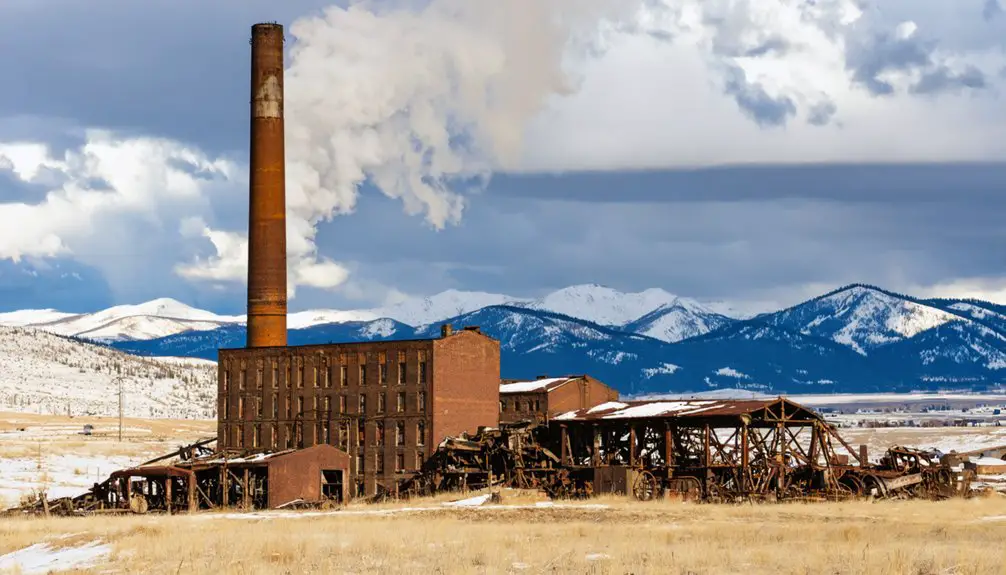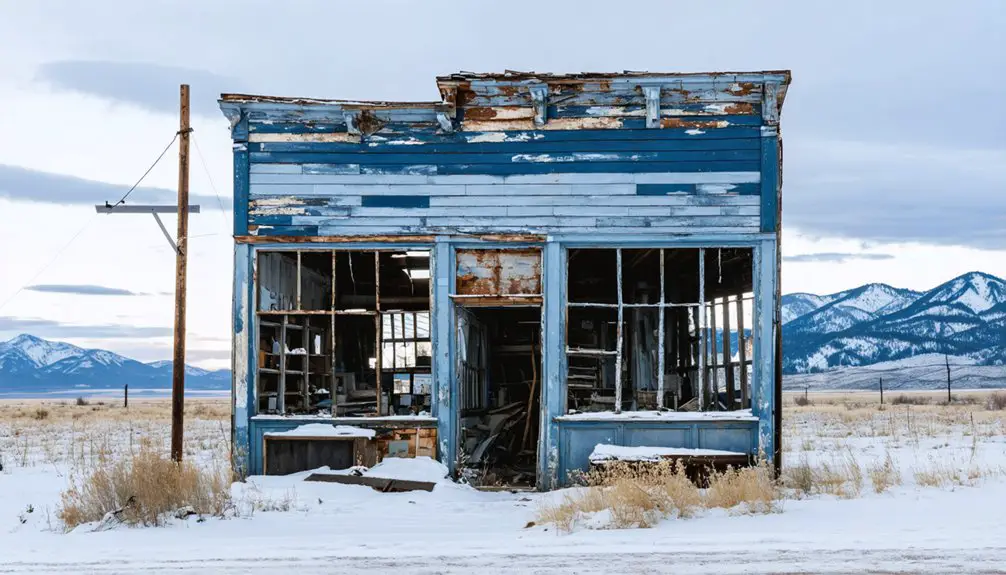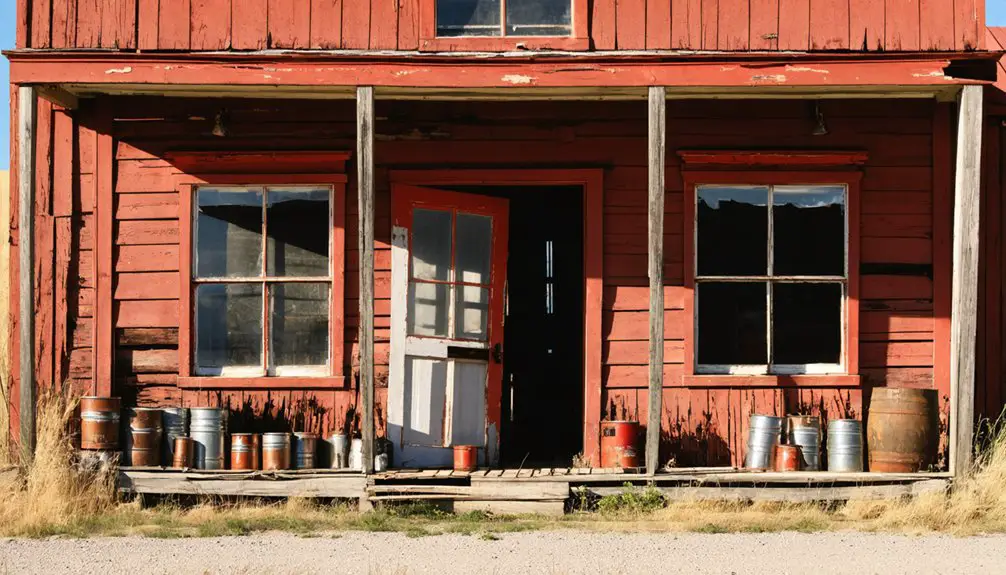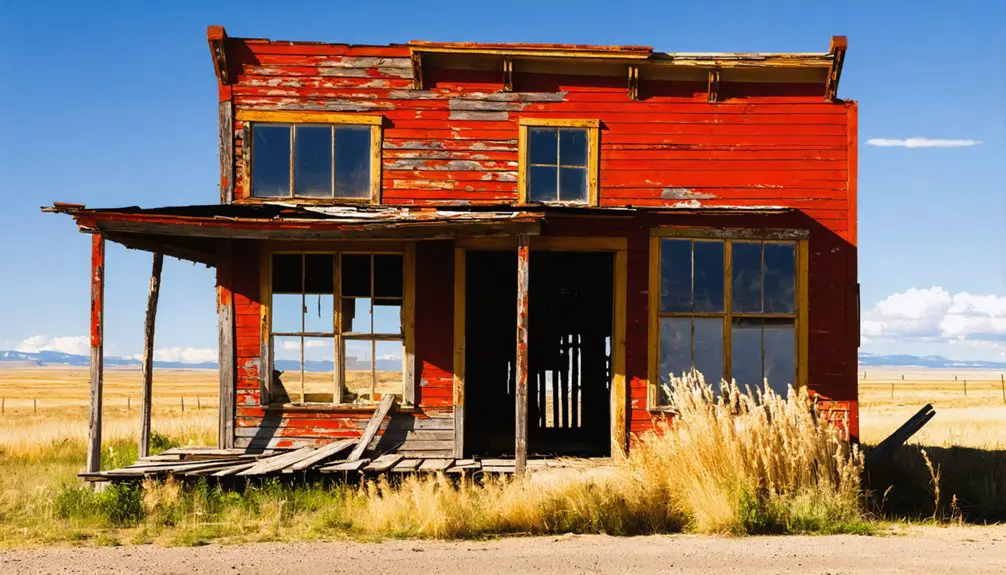You’ll find Wickes in Montana’s Colorado mining district, where prospectors first discovered silver in 1864. William W. Wickes and Eastern investors transformed it into Montana’s second-largest silver producer during the 1880s boom, complete with advanced smelters and massive charcoal kilns. Though natural disasters and economic instability eventually led to its decline, you can still explore the ghost town’s remnants, including the historic Alta mine and six towering kilns that tell a deeper story of Western mining innovation.
Key Takeaways
- Wickes was Montana’s second-largest silver producer during the 1880s before declining into a ghost town due to economic instability.
- The town developed around silver mining operations after William W. Wickes and Eastern investors brought significant financial investment.
- Advanced smelting operations and six massive charcoal kilns made Wickes a major ore processing center in Montana.
- Railroad connections and technological improvements briefly boosted mining profitability, reducing processing costs from $100 to $12 per ton.
- Natural disasters, economic challenges, and the relocation of the Wickes smelter in 1889 contributed to the town’s abandonment.
A Mining Pioneer’s Dream: Origins of Wickes

While prospectors first discovered lode deposits in Montana’s Colorado district in 1864, it wasn’t until William W. Wickes and his fellow Eastern investors brought their financial muscle that the area truly flourished.
You’ll find the story begins with the Gregory mine‘s early production, though smelting challenges forced costly ore shipments all the way to Wales.
Mining innovations took a leap forward when the rich Alta mine vein discovery in 1869 attracted serious capital investment. The establishment of a local smelter operation in 1877 transformed the settlement into a bustling mining town.
The Silver and Gold Rush Years
As silver mining took off in the late 1870s, the Bland-Allison Act’s mandate for government silver purchases transformed Wickes into a bustling boomtown. Deposits were rich but limited in depth, making it crucial to extract maximum value while possible.
You’d have witnessed remarkable economic growth as railroads slashed transportation costs and new technologies made mining more profitable. The Alta Montana Company led the charge, investing millions in expanding operations while building modern reduction works.
- Mining costs plummeted dramatically – ore that once required $100 per ton to process could now be mined for just $12.
- The Northern Pacific Railroad’s arrival in 1884 revolutionized shipping, paired with an innovative rope tramway system for ore transport.
- New smelting operations under Helena Mining and Reduction Company pushed Wickes to become Montana’s “Leadville,” making it the territory’s second-largest silver producer during the 1880s boom.
The town reached its peak population of 300 combined residents when it merged with neighboring Comet in the 1880s.
Industrial Heritage: Smelters and Refineries

When the mining boom hit Jefferson County in the late 19th century, Wickes and nearby Corbin became major centers of ore processing with their state-of-the-art smelters.
You’ll find that smelting technology evolved rapidly here, processing silver-lead ore primarily from the Alta mine. Six massive charcoal kilns, dating to 1881, fueled these operations, producing 25,000 bushels monthly.
The Helena Mining and Reduction Company modernized the Wickes smelter before relocating it to East Helena in 1889.
This move marked a significant shift toward centralized refining, driven by better rail access and operational efficiency.
Today, you can still explore the remnants of these industrial giants – the charcoal kilns and smelter foundations stand as silent sentinels, reminding you of the area’s rich mining heritage.
Life in a Montana Mining Town
Since Montana’s mining boom attracted fortune seekers from across the globe, towns like Wickes developed into vibrant, diverse communities where life centered around the demanding rhythms of mining operations.
The social institutions you’d find reflected the town’s multicultural character, from saloons to schools, creating a unique blend of community dynamics. Similar to Bannack and Butte, mining operations drove the town’s growth and development. Labor organizing became crucial as immigrant workers faced harsh conditions.
Saloons and schools alike brought together Montana’s diverse mining communities, weaving a rich social tapestry in frontier towns.
You’d encounter miners, merchants, and service providers living in hastily-built structures clustered along main streets, all pursuing their own versions of prosperity.
- You could join fellow residents at bustling saloons and entertainment venues after grueling mine shifts
- You’d find diverse ethnic groups contributing their traditions to the town’s cultural fabric
- You’d experience the ups and downs of boom-and-bust cycles that defined life in these freedom-seeking communities
Natural Disasters and Economic Challenges

Though Wickes appeared poised for long-term success in Montana’s mining industry, both natural and economic forces conspired against its survival.
You’ll find that natural disasters common to Montana, including floods, earthquakes, and severe storms, posed constant threats to the town’s infrastructure and mining operations.
The town’s economic instability became evident through a series of setbacks. After the 1867 Gregory smelter failed, you’d have seen precious ore shipped at great expense to distant locations like St. Louis and Wales.
The devastating 1882 mill fire forced debt restructuring and a takeover by Helena Mining and Reduction Company. The Northern Pacific Railroad line that opened shortly after provided a brief boost to local mining operations.
These challenges, combined with Montana’s harsh mountain environment and the region’s vulnerability to flooding and weather damage, ultimately contributed to Wickes’ decline from a promising mining center to a ghost town.
Legacy of the Alta and Gregory Mines
The Alta and Gregory mines stood as cornerstones of Wickes’ mining legacy, despite the town’s eventual decline.
You’ll find that the Alta Mine, discovered in 1869, quickly became Montana’s silver powerhouse, yielding an impressive $32 million in ore by 1893. The Gregory Mine, one of the district’s earliest producers, helped establish the area’s reputation after its 1864 discovery. Like many operations across Montana, the mines relied on hard rock mining techniques to extract precious metals from mineral-bearing ores.
- The Alta Mine’s vast network stretched through 30 miles of underground tunnels, reaching depths of 1,600 feet.
- Between 1904-1919, the mines produced over 2.8 million ounces of silver and 10,453 ounces of gold.
- Eastern investors poured millions into the operations, with the Montana Mining Company leading development.
The mines’ combined output of precious metals shaped Montana’s mining industry, leaving an indelible mark on the territory’s economic development.
Exploring the Ghost Town Today

Visitors approaching Wickes today will find a haunting collection of industrial ruins nestled in Montana’s mountainous terrain, about 5 miles west of Jefferson City.
You’ll reach the site via Interstate 15, taking the Jefferson City interchange to Corbin Road, then connecting to Wickes Road.
While exploring ruins of the massive smelters and charcoal kilns that once produced 25,000 bushels monthly, you’ll witness remnants of Montana’s robust mining heritage.
The site sits at 5,197 feet elevation, offering a raw, unfiltered glimpse into 19th-century industrial operations.
However, visitor safety is essential – you’ll encounter unstable structures and rugged terrain without modern amenities.
There’s minimal interpretive signage, so research beforehand to fully appreciate the historical significance of this industrial archaeological site that once processed millions in ore.
Preserving Montana’s Mining History
Preserving Montana’s rich mining heritage demands coordinated efforts from multiple organizations, including the Montana Bureau of Mines and Geology (MBMG), which has safeguarded essential mining records since 1919.
You’ll find historical documentation efforts spanning from Butte’s copper empire to remote ghost towns, with preservation initiatives protecting both physical structures and crucial records. The MBMG’s extensive collection includes thousands of mining maps and engineering reports documenting Montana’s mineral resources.
- The Montana Heritage Commission manages historic mining properties in Virginia City and Nevada City, overseeing 100 acres of claims and countless artifacts.
- The USDA Forest Service’s Passport In Time program actively restores historic mine sites through community engagement.
- Butte’s National Historic Landmark District protects over 4,500 historical structures while balancing environmental restoration.
Through these mining preservation efforts, you’re able to explore Montana’s mining legacy firsthand, with digitized archives and restored sites offering windows into the state’s transformative past.
Frequently Asked Questions
Were Any Notorious Outlaws or Criminals Associated With Wickes During Its Heyday?
You won’t find documented outlaw activities or a notable criminal legacy in Wickes’ history. Unlike other Montana boomtowns, historical records show it was more focused on mining than attracting infamous criminals.
What Was the Average Wage for Miners Working in Wickes?
You’d have earned about $3-$5 per day as a miner, though mining wages could fluctuate based on economic conditions, company stability, and frequent payment delays in late 19th-century Wickes.
Did Native American Tribes Have Any Significant Interactions With Wickes?
While Native Americans used the broader region, you won’t find significant evidence of tribal relations or cultural exchanges specific to Wickes during its mining era, though displacement likely affected traditional lands.
What Happened to the Families and Descendants of Wickes’s Original Settlers?
While some settler legacies faded into ghost town history, you’ll find that most families migrated to nearby towns like Helena and Jefferson City, pursuing new opportunities in mining, ranching, and urban industries.
Were There Any Documented Paranormal Activities or Ghost Stories From Wickes?
While you’ll find ghost sightings reported in nearby mining towns, there aren’t well-documented paranormal activities specific to Wickes, though the area shares regional characteristics of haunted locations common to abandoned mining communities.
References
- https://westernmininghistory.com/towns/montana/wickes/
- https://en.wikipedia.org/wiki/Wickes
- http://www.ghosttowngallery.com/htme/wickes.htm
- https://www.mtghosttowns.com/comet
- https://www.youtube.com/watch?v=nBcifd-62Ek
- https://mbmg.mtech.edu/pdf/geologyvolume/ReedDillesButteChapter_Final.pdf
- https://www.mtmemory.org/nodes/view/127916
- https://montanahistoriclandscape.com/tag/wickes-montana/
- https://www.explorebigsky.com/the-glory-days-of-comet-montana/22805
- https://www.youtube.com/watch?v=46zjlXceY9w



